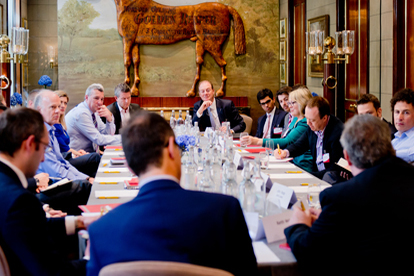Expert: Marco Lo Blanco, research analyst and portfolio manager, Seilern Investment Management Facilitator: Sam Shaw, independent consultant
Headlines:
- A rigorous process is the only thing to cling to when “being battered by the waves”
- Remuneration policy can be a divisive feature – important to ensure aligned interests while eliminating risk of ‘style drift’
- Weighing up the balance between process, performance and asset gathering will create tension at times
Context:
This session introduced Seilern’s process & philosophy, in which 10 golden rules, combined with an analyst-first model allow Seilern to block out the noise and retain focus.
One investment philosophy for 30 years: developed market quality growth, high-conviction, low turnover funds based on proprietary research. Fund managers are first and foremost research analysts, focused on 7-8 stocks, permitting them time to really delve into the investment case around a new idea.
The process looks for the best companies in the world from a universe of 50-70 companies, optimally those that can reliably grow earnings (because 75% of total return of a stock over is driven by earnings over a 10-20-year timeframe).
Seilern subscribes to 10 ‘common sense’ rules, where each investment must tick all the boxes, all of the time. These rules identify companies that can help to generate sustainable growth and help prevent a permanent loss of capital. Their 10 golden rules are:
- Superior Industry Growth / Consistent Industry Leadership / Scalable Business Model / Sustainable Competitive Advantage / Strong Organic Growth / Wide Geographic & Customer Diversification / Low Capital Intensity & High ROIC / Solid Financial Position / Transparent Accounts / Excellent Management & Governance
Discussion:
Scepticism was voiced around how this process and fund was truly different to other quality growth propositions. Seilern said the philosophy was tried and tested but it’s how those principles are put into action that will differentiate one quality growth fund from another.
The question was raised as to why focus on well-researched, large & mega-cap growth companies rather than delve into lesser known, SMID space. Seilern’s response was over risk of earlier-stage, less reliable forecasting ability, smaller customer base, less pricing power etc. (They would also question whether large cap companies are well-researched and that it is a popular misconception that familiar companies are well researched.)
Regionally, the focus is on OECD countries while gaining exposure to the emerging market consumer, indirectly. There is a desire to avoid risks such as changes in government regime, or legal and regulatory ramifications to ensure they can always repatriate clients’ capital.
The importance of process in volatile times
There was discussion around the importance of a tightly defined process versus being more flexible, adapting to reflect the changing backdrop.
- One delegate stated: “Process is something to cling to; the guiding star to steer you away from all the distraction when things are more chaotic.”
- Another felt it was important to be nimbler when prevailing conditions are so uncertain: “How can you be so wedded to investment principles in such an environment, don’t you have to adapt to survive?”
But the framework allowed for flexibility if the fundamentals of a particular sector had changed. E.g., barriers to entry to distribute consumer staples had lowered through the rise of online.
When volatility is the highest, visibility is the lowest, presenting the most likely chance of making mistakes. It is arguably more difficult to hold your nerve during times of crisis without a clear and robust discipline in place. Also, remaining invested over time, rather than trying to market-time will benefit from compounding effects – particularly helpful during inflationary periods.
Bias, style drift and remuneration policy
Gatekeepers do see – and are frustrated by – style drift (e.g., from value focus to a ‘reframed’ growth tilt). When it works against you – because you build overall portfolios expecting a certain blend of styles – it’s hard to justify to clients and you don’t see it happening until it’s too late.
Firm is employee-owned so remuneration does not motivate style drift to attract inflows. A ‘challenge culture’ is encouraged; ideas must be approved unanimously by the research team. Yet the point was raised about ‘groupthink’ if everyone is driven by such a well-defined process.
Important to understand biases and point them out when they happen. E.g., could someone be anchoring; running a stock too long, even though its performance has been mediocre? The team can redirect resources to mitigate the effects of biases when they creep in.
Fund manager remuneration preferences varied around the table. Some delegates wanted the PM to be paid on performance, which they felt demonstrated an alignment of interests.
How does strict adherence to a process map against long-term objectives of the firm?
It raised questions over the long-term objectives of the group (asset gathering, outperformance, etc). Seilern stressed it was a commercial decision; weighing up AUM while insisting its process must not be compromised.
- If it was unable to invest in Rightmove at some point in future, that would be a concern because the process would come under pressure due to due to size & liquidity constraints.
Key takeaways:
- Are we facing a paradigm shift? For asset allocators the questions are around inflation persistency and the extent to which these high-growth businesses will be derated, and how long for.


